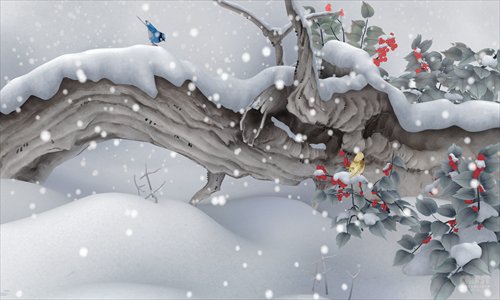
One scene from The Plume,a 3D ink-wash animated short (Photo: Courtesy of China Research Institute of Film Science & Technology)
Artists give a Chinese traditional art form new legs
Huang Ying, an associate professor at Beijing Film Academy's Animation School is looking to breathe new life into the traditional art of ink-wash animation.
Huang's latest digital ink-wash animated short called The Plume will be shown in the Fifth Beijing International Film Festival (BJIFF), which will kick off on April 16. Its ultra high-definition 2D and 3D versions will also be released in the coming weeks.
"This short film will present traditional gongbi-style (a realistic Chinese painting technique defined by its detail and fine brush work) paintings via a beautiful world of flowers and birds with stereoscopic visual effects," said Huang, who started work on the project in 2013.
Huang is just one of many modern animation artists who use 3D animation and other technology to create new ink-wash animations as a way to revive this traditional art, which saw its peak in the 1980s.
The recent passing of Ma Kexuan, a famous Chinese ink-wash animation director from Shanghai Animation Film Studio (SAFS), on April 6 has once again brought Chinese ink-wash animations under the national spotlight.
Animated works that feature Chinese ink-wash paintings are those created by applying ink-wash painting techniques such as gongbi and xieyi (freehand brush work) to the creation of animations.
Unlike traditional ink-wash animation, Huang calls her works "new" ink-wash animations because the techniques used to make them are very different from the classic creations by SAFS.
"Traditional techniques required a lot of time and manpower, which is not realistic to use today," Huang said. "We try to use new techniques, such as 3D animation software, to simulate the effect of ink-wash paintings such as shading. With 3D technology, we also break the tradition of using lateral shots and use rotated shots to make the moving pictures more vivid."
Before this project, Huang created three 3D animated shorts, A Pond (2001), The Pond (2003) and The Nest (2004). A Pond and The Pond have won more than 10 national and international animation awards.
A Pond and The Pond have made it possible to reinvent both the xieyi and gongbi styles of painting by using 3D technology, said Sun Lijun, director of the Animation School of Beijing Film Academy, who also was the instructor for these two works.
Similar works that have won many national and international awards are Ode to Summer (2003) and The Legend of Shangri-La (2006), both produced by Shenzhen-based Institute of Digital Media Technology Limited Corporation (IDMT).
"In addition to using ink-wash paintings, The Legend of Shangri-La also applied the style of a Shaanxi shadow puppet show's movement to the computer animation, creating a unique visual style," said Xiao Yong, general manager of IDMT.
Though their works have won much praise home and abroad, Xiao said they have not been released in cinemas and on TV because these projects have been more like experiments, rather than commercial endeavors.
Sun said that due to its monotonous and limited expressive form of black and white and its huge costs, ink-wash animation will likely still remain a niche part of the animation industry.
Xiao estimated that a 10-minute ink-wash animated short using 3D technology costs more than 1 million yuan ($620,800) to make. If it lasts 80 minutes, about the length of a feature film, it could cost more than 20 million yuan.
Sun said that because China has many beautiful traditional art forms such as paper-cutting, shadow puppet and woodcut, artists should not have to be confined to one art form and should use new technology to integrate them.
"I think to develop Chinese traditional ink-wash animations, the key is to be diverse. As long as you combine diverse traditional art forms with ink-wash animations, you can open a bigger market," Sun said.
















































